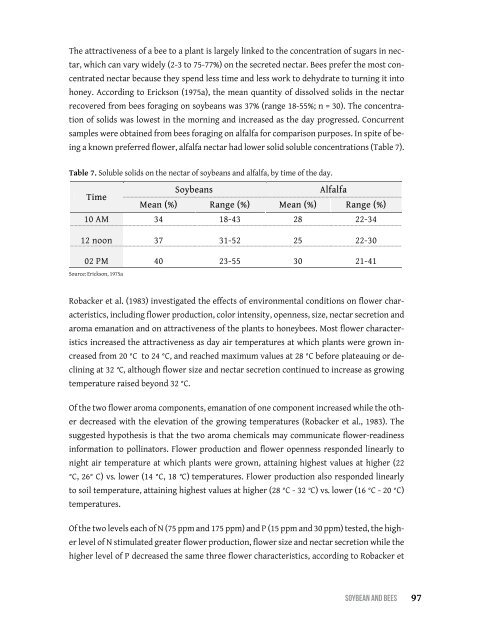Soybean and Bees
Create successful ePaper yourself
Turn your PDF publications into a flip-book with our unique Google optimized e-Paper software.
The attractiveness of a bee to a plant is largely linked to the concentration of sugars in nectar,<br />
which can vary widely (2-3 to 75-77%) on the secreted nectar. <strong>Bees</strong> prefer the most concentrated<br />
nectar because they spend less time <strong>and</strong> less work to dehydrate to turning it into<br />
honey. According to Erickson (1975a), the mean quantity of dissolved solids in the nectar<br />
recovered from bees foraging on soybeans was 37% (range 18-55%; n = 30). The concentration<br />
of solids was lowest in the morning <strong>and</strong> increased as the day progressed. Concurrent<br />
samples were obtained from bees foraging on alfalfa for comparison purposes. In spite of being<br />
a known preferred flower, alfalfa nectar had lower solid soluble concentrations (Table 7).<br />
Table 7. Soluble solids on the nectar of soybeans <strong>and</strong> alfalfa, by time of the day.<br />
Time<br />
<strong>Soybean</strong>s<br />
Alfalfa<br />
Mean (%) Range (%) Mean (%) Range (%)<br />
10 AM 34 18-43 28 22-34<br />
12 noon 37 31-52 25 22-30<br />
02 PM 40 23-55 30 21-41<br />
Source: Erickson, 1975a<br />
Robacker et al. (1983) investigated the effects of environmental conditions on flower characteristics,<br />
including flower production, color intensity, openness, size, nectar secretion <strong>and</strong><br />
aroma emanation <strong>and</strong> on attractiveness of the plants to honeybees. Most flower characteristics<br />
increased the attractiveness as day air temperatures at which plants were grown increased<br />
from 20 °C to 24 °C, <strong>and</strong> reached maximum values at 28 °C before plateauing or declining<br />
at 32 °C, although flower size <strong>and</strong> nectar secretion continued to increase as growing<br />
temperature raised beyond 32 °C.<br />
Of the two flower aroma components, emanation of one component increased while the other<br />
decreased with the elevation of the growing temperatures (Robacker et al., 1983). The<br />
suggested hypothesis is that the two aroma chemicals may communicate flower-readiness<br />
information to pollinators. Flower production <strong>and</strong> flower openness responded linearly to<br />
night air temperature at which plants were grown, attaining highest values at higher (22<br />
°C, 26° C) vs. lower (14 °C, 18 °C) temperatures. Flower production also responded linearly<br />
to soil temperature, attaining highest values at higher (28 °C - 32 °C) vs. lower (16 °C - 20 °C)<br />
temperatures.<br />
Of the two levels each of N (75 ppm <strong>and</strong> 175 ppm) <strong>and</strong> P (15 ppm <strong>and</strong> 30 ppm) tested, the higher<br />
level of N stimulated greater flower production, flower size <strong>and</strong> nectar secretion while the<br />
higher level of P decreased the same three flower characteristics, according to Robacker et<br />
SoybeAn <strong>and</strong> bees<br />
97


